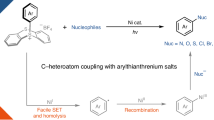Abstract
THE recent preparation of kryptates1 and xenates2 by Grosse et al. opens a new chapter in rare-gas chemistry. Up to now the compounds that have been made have presented no new problems in chemical bonding; no problems that were not already present in the chemistry of iodine and tellurium, etc. Most of the fluorine and oxygen compounds of xenon that have been prepared have isoelectronic analogues in the chemistry of iodine, for example, XeF6(IF6−), XeF4(IF4−), XeF2(ICl2−), XeO3 (IO3−) and XeO64−(IO65−). Xenates based on XeO66− are therefore a new type of compound. Similarly krypton forms KrO3(BrO3−), but kryptates (KrO4−−, KrO66−?) have no isoelectronic counterparts.
This is a preview of subscription content, access via your institution
Access options
Subscribe to this journal
Receive 51 print issues and online access
$199.00 per year
only $3.90 per issue
Buy this article
- Purchase on Springer Link
- Instant access to full article PDF
Prices may be subject to local taxes which are calculated during checkout
Similar content being viewed by others
References
Streng, A. G., and Grosse, A. V., Science, 143, 243 (1964).
Kirschenbaum, A. D., and Grosse, A. V., Science, 142, 580 (1963).
Craig, D. P., and Zauli, C., J. Chem. Phys., 37, 601, 609 (1962).
Coulson, C. A., Valence, 71 (Oxf. Univ. Press, 1952).
Urch, D. S., J. Inorg. Nuclear Chem., 25, 771 (1963).
Calculated by method of H. H. Jaffe (J. Chem. Educ., 33, 25; 1956) from data by C. E. Moore, Tables of Atomic Energy Levels (Nat. Bur. Stand. Circ. No. 467 U.S. Gov. Printing Office, 1949–52).
Pauling, L., The Nature of the Chemical Bond, third ed., 540 (Cornell Univ. Press, Ithaca, N.Y., 1960).
Pauling, L., and Wilson, E. B., Introduction to Quantum Mechanics, 135 (McGraw-Hill, New York, 1935).
Huston, J. L., Studier, M. H., and Sloth, E. N., Science, 143, 1161 (1964). Selig, H., Claassen, H. H., Chernick, C. L., Malm, J. G., and Huston, J. L., Science, 143, 1322 (1964).
Author information
Authors and Affiliations
Rights and permissions
About this article
Cite this article
URCH, D. Electronic Structures of Kryptates and Xenates. Nature 203, 403–404 (1964). https://doi.org/10.1038/203403b0
Issue Date:
DOI: https://doi.org/10.1038/203403b0
Comments
By submitting a comment you agree to abide by our Terms and Community Guidelines. If you find something abusive or that does not comply with our terms or guidelines please flag it as inappropriate.



